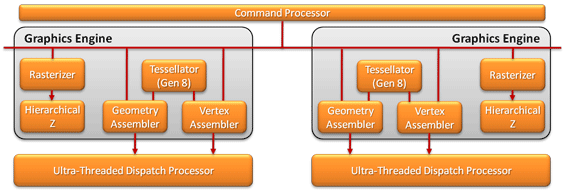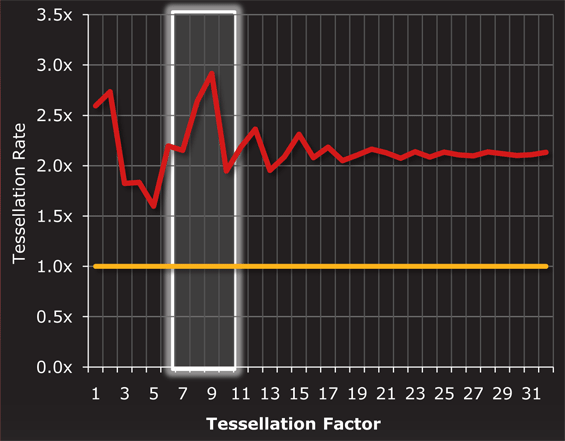AMD's Radeon HD 6970 & Radeon HD 6950: Paving The Future For AMD
by Ryan Smith on December 15, 2010 12:01 AM ESTAdvancing Primitives: Dual Graphics Engines & New ROPs
AMD has clearly taken NVIDIA’s comments on geometry performance to heart. Along with issuing their manifesto with the 6800 series, they’ve also been working on their own improvements for their geometry performance. As a result AMD’s fixed function Graphics Engine block is seeing some major improvements for Cayman.
Prior to Cypress, AMD had 1 graphics engine, which contained 1 each of the fundamental blocks: the rasterizers/hierarchical-Z units, the geometry/vertex assemblers, and the tessellator. With Cypress AMD added a 2nd rasterizer and 2nd hierarchical-Z unit, allowing them to set up 32 pixels per clock as opposed to 16 pixels per clock. However while AMD doubled part of the graphics engine, they did not double the entirety of it, meaning their primitive throughput rate was still 1 primitive/clock, a typical throughput rate even at the time.

Cypress's Graphics Engine
In 2010 with the launch of Fermi, NVIDIA raised the bar on primitive performance, with rasterization moved to NVIDIA’s GPCs, NVIDIA could theoretically push out as many primitives/clock as they had GPCs, in the case of GF100/GF110 pushing this to 4 primitives/clock, a simply massive improvement in geometry performance for a single generation.
With Cayman AMD is catching up with NVIDIA by increasing their own primitive throughput rate, though not by as much as NVIDIA did with Fermi. For Cayman the rest of the graphics engine is being fully duplicated – Cayman will have 2 separate graphics engines, each containing one fundamental block, and each capable of pushing out 1 primitive/clock. Between the two of them AMD’s maximum primitive throughput rate will now be 2 primitives/clock; half as much as NVIDIA but twice that of Cypress.

Cayman's Dual Graphics Engines
As was the case for NVIDIA, splitting up rasterization and tessellation is not a straightforward and easy task. For AMD this meant teaching the graphics engine how to do tile-based load balancing so that the workload being spread among the graphics engines is being kept as balanced as possible. Furthermore AMD believes they have an edge on NVIDIA when it comes to design - AMD can scale the number of eraphics engines at will, whereas NVIDIA has to work within the logical confines of their GPC/SM/SP ratios. This tidbit would seem to be particularly important for future products, when AMD looks to scale beyond 2 graphics engines.
At the end of the day all of this tinking with the graphics engines is necessary in order for AMD to further improve their tessellation performance. AMD’s 7th generation tessellator improved their performance at lower tessellation factors where the tessellator was the bottleneck, but at higher tessellation factors the graphics engine itself is the bottleneck as the graphics engine gets swamped with more incoming primitives than it can set up in a single clock. By having two graphics engines and a 2-primitive/clock rasterization rate, AMD is shifting the burden back away from the graphics engine.
Just having two 7th generation-like tessellators goes a long way towards improving AMD’s tessellation performance. However all of that geometry can still lead to a bottleneck at times, which means it needs to be stored somewhere until it can be processed. As AMD has not changed any cache sizes for Cayman, there’s the same amount of cache for potentially thrice as much geometry, so in order to keep things flowing that geometry has to go somewhere. That somewhere is the GPU’s RAM, or as AMD likes to put it, their “off-chip buffer.” Compared to cache access RAM is slow and hence this isn’t necessarily a desirable action, but it’s much, much better than stalling the pipeline entirely while the rasterizers clear out the backlog.

Red = 6970. Yellow = 5870
Overall, clock for clock tessellation performance is anywhere between 1.5x and 3x that of Cypress. In situations where AMD’s already improved tessellation performance at lower tessellation factors plays a part, AMD approaches 3x performance; while at around a factor of 5 the performance drops to near 1.5x. Elsewhere performance is around 2x that of Cypress, representing the doubling of graphics engines.
Tessellation also plays a factor in AMD’s other major gaming-related improvement: ROP performance. As tessellation produces many mini triangles, these triangles begin to choke the ROPs when performing MSAA. Although tessellation isn’t the only reason, it certainly plays a factor in AMD’s reasoning for improving their ROPs to improve MSAA performance.
The 32 ROPs (the same as Cypress) have been tweaked to speed up processing of certain types of values. In the case of both signed and unsigned normalized INT16s, these operations are now 2x faster. Meanwhile FP32 operations are now 2x to 4x faster depending on the scenario. Finally, similar to shader read ops for compute purposes, ROP write ops for graphics purposes can be coalesced, improving performance by requiring fewer operations.










168 Comments
View All Comments
529th - Sunday, December 19, 2010 - link
Great job on this review. Excellent writing and easy to read.Thanks
marc1000 - Sunday, December 19, 2010 - link
yes, that's for sure. we will have to wait a little to see improvements from VLIW4. but my point is the "VLIW processors" count, they went up by 20%. with all other improvements, I was expecting a little more performance, just that.but in the other hand, I was reading the graphs, and decided that 6950 will be my next card. it has double the performance of 5770 in almost all cases. that's good enough for me.
Iketh - Friday, December 24, 2010 - link
This is how they've always reviewed new products? And perhaps the biggest reason AT stands apart from the rest? You must be new to AT??WhatsTheDifference - Sunday, December 26, 2010 - link
the 4890? I see every nvidia config, never a card overlooked there, ever, but the ATI's (then) top card is conspicuously absent. long as you include the 285, there's really no excuse for the omission. honestly, what's the problem?PeteRoy - Friday, December 31, 2010 - link
All games released today are in the graphic level of the year 2006, how many games do you know that can bring the most out of this card? Crysis from 2007?Hrel - Tuesday, January 11, 2011 - link
So when are all these tests going to be re-run at 1920x1080 cause quite frankly that's what I'm waiting for. I don't care about any resolution that doesn't work on my HDTV. I want 1920x1080, 1600x900 and 1280x720. If you must include uber resolutions for people with uber money then whatever; but those people know to just buy the fastest card out there anyway so they don't really need performance numbers to make up their mind. Money is no object so just buy nvidia's most expensive card and ur off.AKP1973 - Thursday, October 13, 2011 - link
Have you guys noticed the "load GPU temp" of the 6870 in XFIRE?... It produced so very low heat than any enthusiast card in a multi-GPU setup. That's one of the best XFIRE card in our time today if you value price, performance, cool temp, and silence.!Travisryno - Wednesday, April 26, 2017 - link
It's dishonest referring to enhanced 8x as 32x. There are industry standards for this, which AMD, NEC, 3DFX, SGI, SEGA AM2, etc..(everybody) always follow(ed), then nVidia just makes their own...Just look how convoluted it is..